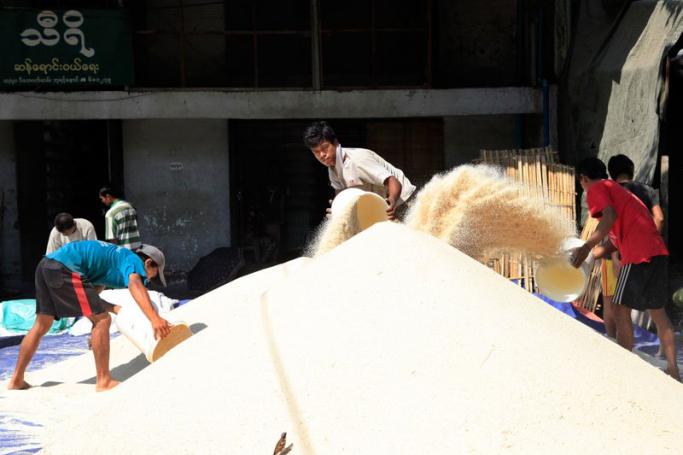Rice exports from Myanmar - the leader in the global trade in the crucial grain five decades ago - surged more than 40% last year and are expected to jump again in 2015, but the country’s return to the world stage comes at a time of falling prices.
According to the latest estimates of the United States Department of Agriculture (USDA), Myanmar’s rice exports in 2014 reached 1.663 million tons, up 43.0% year-on-year. The government has reportedly set a target of exporting 2.5 million tons in fiscal 2015/16, ending March 31, but the prices they fetch may prove disappointing, especially if Myanmar doesn’t improve its warehousing facilities to store the grain.
Where does that place Myanmar in relation to the world’s top rice exporter?
Thailand exports roughly six times as much rice as Myanmar. The country, which dethroned Myanmar as the world’s number one rice exporter in the mid-1960s, saw an even more dramatic rise in exports last year. The kingdom’s total rice exports reached 10.969 million tons, up 63.2% from their 2013 performance, according to USDA figures released April 10. Thailand lost the top rice exporter slot to India in 2012 and 2013 as a direct result of the previous government’s populist policy of buying up the entire paddy (unhusked rice) crop at 40-50% above the market price. With Thailand back in the race last year, India’s rice exports in 2014 hit 10.901 million tons, only slightly behind Thai shipments, according to USDA figures.
Neither the Thai government nor the private sector could sell off their overpriced grain on the world market between 2012 to 2013, leaving the country with a giant stockpile of rice in rented warehouses nationwide, estimated at anywhere between 14 to 18 million tons. Last year’s surge in shipments was largely due the termination of direct government involvement in exports, following the May coup, and letting the very competitive Thai private sector do their thing. But this year, even Thailand’s private sector rice traders are worried.
“This year I was thinking we could sell 12 million tons, but now it doesn’t look that way,” said Vichai Sriprasert, Honorary President of the Thai Rice Exporters Association. “There is no demand. The whole world is not in normal circumstances anymore,” he said. Thailand’s rice shipments averaged about 700,000 tons per month during the January to March period, and prices have been steadily falling. Thailand’s 5% broken rice (which sets the world standard for prices) end the month of March at $390 per ton, down 4% from the previous month, according to the Oryza.Com.Vietnam’s 5% broken rice was selling even cheaper, at $370 per ton, according to the online rice newsletter.
International rice prices have been on the decline since September 2014, hitting a four-year low in March, according to the latest Food and Agriculture (FAO) update on the rice industry. Prices have remained depressed despite huge losses in Thailand’s second rice crop due to an unusually severe drought. “Nobody understands why the prices are so low,” Vichai said. “We are in the dark.” One can speculate, however. “If I was forced to give an opinion, I would say world demand is much less for rice because of the economic situation,” he said. The world’s leading economies – USA, Europe, Japan and China – are slowing, and commodity prices have been falling across the board, starting with oil prices. The Middle East and parts of Africa have also witnessed an upsurge in fighting, making shipments of rice to these important markets risky. “Iraq and Iran, all these countries are very important to the rice market. You’re talking millions of tons,” Vichai said.
Another factor affecting rice prices is rice stockpiles, which remain huge. India and Thailand have accumulated massive stockpiles of rice, according to the FAO, inevitably affected the market outlook as the two countries are the world’s leading exporters. Although the FAO predicts a 2.4% decline in the stockpiles this year from their opening level of 176.6 million tons, there is still a lot of grain out there ready to flood the market at the opportune time. “While the stockpiles are sitting around, there is probably not going to be much upward movement on rice prices,” said David Dawe, Senior Economist at the FAO regional office in Bangkok.
Thailand’s military government has succeeded in offloading about 1.18 million tons in five public auctions held since May, but it cancelled an auction planned in April to avoid impacting prices fetched by Thai farmers whose second crop was already hard hit by drought. “They are trying to balance between liquidating the stock and keeping the price relatively stable so farmers don’t suffer, but you can’t achieve both,” Vichai said.
Add to this mix the advent of newcomers to the international rice market, and the price picture promises to get bleaker. According to the FAO, last year the international trade in rice grew 14% from 2013, to reach a new peak of 42.4 million tons, with the main importers being Bangladesh, China, Indonesia, Malaysia, the Philippines and Sri Lanka. The UN organization estimates that the rice trade will reach 41.3 million tons in 2015, only a smidgeon less than last year’s. Some of this business will be captured by relative newcomers such as Cambodia and Myanmar. Cambodia’s rice exports during the first quarter of 2015, rose 77% year-on-year to 149,464 tons, according to Oryza.Com. That doesn’t necessarily bode well for rice prices. “You’ve got these new competitors, and you’ve already got a lot of stock sitting out there,” FAO’s Dawe noted.
Rice exports by the main players, in millions of tons:
2013
2014
Cambodia
1,075
1,000
India
10,480
10,901
Myanmar
1,163
1,663
Pakistan
4,126
3,300
Thailand
6,722
10,969
USA
3,293
3,042
Vietnam
6,700
6,325
World Total
39,455
43,057
Source USDA, April 10, 2015
This Article first appeared in the May 7, 2015 edition of Mizzima Weekly.
Mizzima Weekly is available in print in Yangon through Innwa Bookstore and through online subscription at www.mzineplus.com












